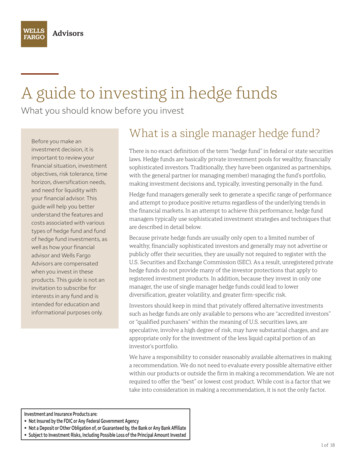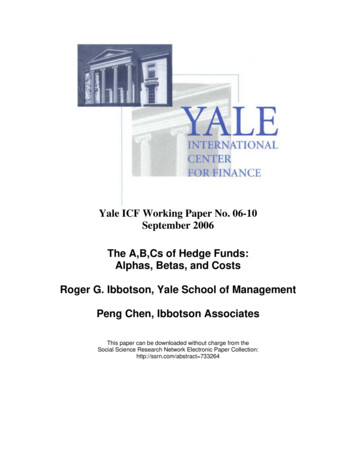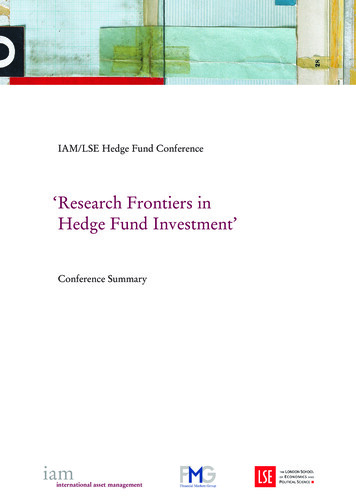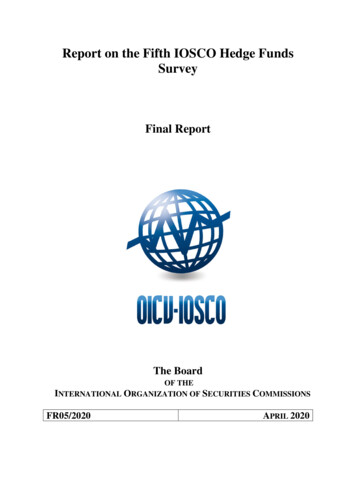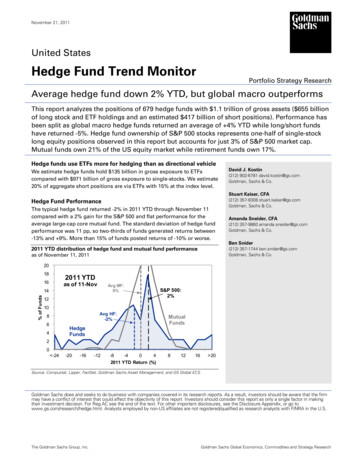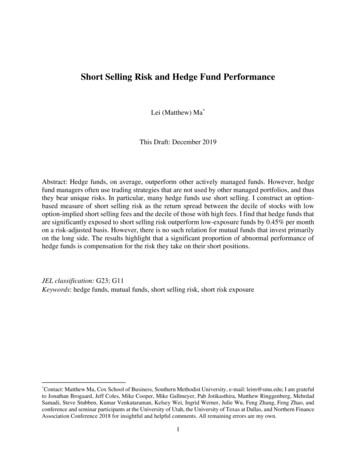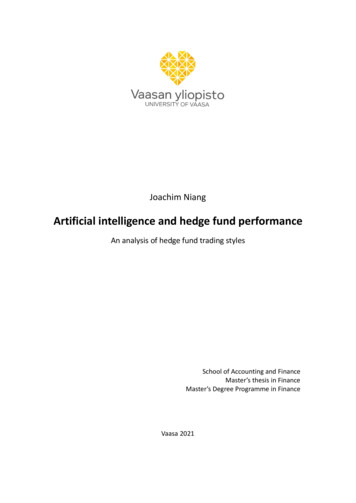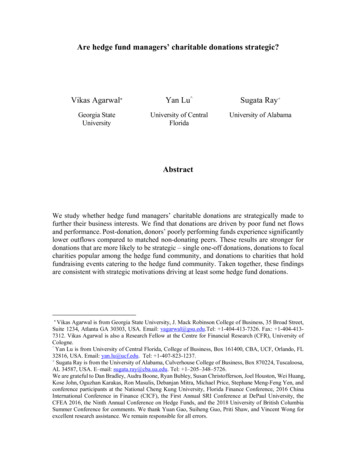
Transcription
Are hedge fund managers’ charitable donations strategic?Vikas Agarwal Yan Lu Sugata Ray Georgia StateUniversityUniversity of CentralFloridaUniversity of AlabamaAbstractWe study whether hedge fund managers’ charitable donations are strategically made tofurther their business interests. We find that donations are driven by poor fund net flowsand performance. Post-donation, donors’ poorly performing funds experience significantlylower outflows compared to matched non-donating peers. These results are stronger fordonations that are more likely to be strategic ‒ single one-off donations, donations to focalcharities popular among the hedge fund community, and donations to charities that holdfundraising events catering to the hedge fund community. Taken together, these findingsare consistent with strategic motivations driving at least some hedge fund donations. Vikas Agarwal is from Georgia State University, J. Mack Robinson College of Business, 35 Broad Street,Suite 1234, Atlanta GA 30303, USA. Email: vagarwal@gsu.edu.Tel: 1-404-413-7326. Fax: 1-404-4137312. Vikas Agarwal is also a Research Fellow at the Centre for Financial Research (CFR), University ofCologne. Yan Lu is from University of Central Florida, College of Business, Box 161400, CBA, UCF, Orlando, FL32816, USA. Email: yan.lu@ucf.edu. Tel: 1-407-823-1237. Sugata Ray is from the University of Alabama, Culverhouse College of Business, Box 870224, Tuscaloosa,AL 34587, USA. E–mail: sugata.ray@cba.ua.edu. Tel: 1–205–348–5726.We are grateful to Dan Bradley, Audra Boone, Ryan Bubley, Susan Christofferson, Joel Houston, Wei Huang,Kose John, Oguzhan Karakas, Ron Masulis, Debanjan Mitra, Michael Price, Stephane Meng-Feng Yen, andconference participants at the National Cheng Kung University, Florida Finance Conference, 2016 ChinaInternational Conference in Finance (CICF), the First Annual SRI Conference at DePaul University, theCFEA 2016, the Ninth Annual Conference on Hedge Funds, and the 2018 University of British ColumbiaSummer Conference for comments. We thank Yuan Gao, Suiheng Guo, Priti Shaw, and Vincent Wong forexcellent research assistance. We remain responsible for all errors.
Are hedge fund managers’ charitable donations strategic?AbstractWe study whether hedge fund managers’ charitable donations are strategically made tofurther their business interests. We find that donations are driven by poor fund net flowsand performance. Post-donation, donors’ poorly performing funds experience significantlylower outflows compared to matched non-donating peers. These results are stronger fordonations that are more likely to be strategic ‒ single one-off donations, donations to focalcharities popular among the hedge fund community, and donations to charities that holdfundraising events catering to the hedge fund community. Taken together, these findingsare consistent with strategic motivations driving at least some hedge fund donations.Keywords: Hedge funds, Philanthropy, Goodwill, Trust, Altruism, Capital FormationJEL Classification: D64, G23, G41
Are hedge fund managers’ charitable donations strategic?Charitable donations by hedge fund managers seem to defy the typical perceptionof these managers being self-serving and only interested in making money for themselves.1While there is a large body of research on some of the drivers of individuals’ charitablegiving (e.g., Karlan and List, 2007), relatively less attention has been paid to the questionof whether business professionals strategically donate their personal wealth to further theirbusiness interests. We address this question by examining the motives behind hedge fundmanagers’ charitable donations and the effects these donations have on the net flows andperformance of the funds they manage.We believe that there are several reasons the hedge fund industry offers a nicesetting to study potentially strategic charitable donations. First, hedge fund managers canuse donations to generate goodwill among current and potential investors, and gain theirtrust. Gennaioli, Shleifer, and Vishny (2015) provide a nice model where investors delegatemoney management to professionals based on trust. The hedge fund industry is oftencharacterized as lightly regulated and highly opaque where investors face significantinformation asymmetry and operational risks (Brown et al., 2008). Consequently, buildingtrust in fund managers can help reduce investors’ perception of the riskiness of theirinvestments (Gennaioli, Shleifer, and Vishny, 2015). This is particularly important duringperiods of poor fund performance which may lead investors to lose trust in their managers’ability. Second, as hedge funds are restricted from advertising, charities’ fundraising eventscan help fund managers network with, and possibly garner investments from, high net1For example, a recent Bloomberg article quotes Erik Townsend, a hedge fund manager at Fourth TurningCapital Management, describing hedge fund managers as ‘“the most self-serving people on the planet,”’while discussing “the stereotype of the hedge fund manager who puts making money first.” (see “WhyStruggling Hedge Fund Managers Give to Charity,” Bloomberg Markets, Dec 19, 2017).1
worth individuals frequenting such events. In addition to capital raising, fund managersmay use the goodwill and connections generated by the donations to obtain valuableinformation that they can use to improve their funds’ performance.Motivated by this background, we examine if hedge fund managers donatestrategically to increase net flows and to improve the performance of their funds, andthereby meet their objective function to maximize the assets under management. Priorliterature indicates hedge fund investors exhibit return-chasing behavior (e.g., Fung et al.,2008; Getmansky et al., 2010; and Jorion and Schwarz, 2015). We believe that managersof poorly performing funds with dwindling flows have stronger strategic incentives todonate. Subsequent to poor fund performance, such managers are more likely to exploreavenues to retain investors’ capital. We argue that one such avenue can be for the managersof these poorly performing funds to make charitable donations.To further investigate the strategic motives behind fund managers’ donations, wealso identify and examine two subsamples of donations that are more likely to be strategiccompared to other donations. One of the strategic aspects of donating relates to “when”managers donate, i.e., the timing of donation. Therefore, our first proxy of strategicdonations is nonrecurring, one-off donation where the fund managers donate when theyneed to raise more capital and/or to improve performance. Such donations are in contrastto recurring donations, which occur periodically and routinely over many years. 2 Oursecond proxy of strategic donations is whether the donation is made to a “focal” charity.We argue that donations made to focal charities, defined as charities with many other hedgefund manager donors, are more likely to be strategic compared to donations made to2This approach is similar to the one used by Cohen, Malloy, and Pomorski (2012) for identifying informativeinsider trades by focusing on the non-routine trades by insiders.2
charities with fewer other hedge fund donors. The underlying premise is that fundraisingevents organized by such charities are likely to attract high net worth individuals, who areone of the main investors in hedge funds. In addition to gaining visibility and trust amongpotential investors, these donations may allow access to and potentially gather informationfrom fellow donors.Finally, as an additional and arguably more direct test of whether such fundraisingevents are a potential channel of asset gathering for hedge fund managers, we examine ifdonations to charities that hold fundraising events catering to the hedge fund communityallow donors’ funds to have higher net flows.Our study uses a large sample of 6,642 charitable donations by 667 hedge fundmanagers between January 1994 and June 2016. We obtain information regardingmanagers’ personal charitable donations from NOZA, the world’s largest searchabledatabase of such donations. We merge this data with fund characteristics and performancefrom the widely used Lipper TASS commercial hedge fund database using manager namesand additional information including the city and state of hedge funds. In our empiricalinvestigation, we focus on larger donations by hedge fund managers as they are more likelyto be associated with strategic intent and materially influence fund investors. The averagedonation is about 325,000 for these large donations, which represents a significantproportion (about 40% on average) of a hedge fund’s annual total income frommanagement fees.Modelling the determinants of donations, we find funds’ poor performance and lownet flows are two major motivations for fund managers’ charitable donations. Theprobability for the managers of poorly performing funds to make a donation is almost3
double that for the managers of relatively well-performing funds. In addition, the donationprobability for the managers in funds with the lowest net flows is about 50% greatercompared to the managers of other funds with higher flows. These findings are striking asprior studies on personal charitable giving suggest financial stability is a strong determinantof giving. Additionally, tax benefits from charitable deductions, another motivation forgiving, are also likely to be more valuable after periods of good performance.3 The factthat hedge fund managers are more likely to give when their funds are doing badly issuggestive of strategic intent behind their gifts.Furthermore, several fund characteristics significantly related to the likelihood offund managers donating are also consistent with managers’ incentives to increase net flowsand fund performance. Both management and incentive fees are positively related to theprobability of donation. If donations can help bring in more capital or improve fundperformance, managers of funds with higher fees can earn greater compensation frommaking donations. The use of high-water marks is also positively related to donations,consistent with the possibility that poorly performing managers may want to attract newinvestors to their funds from whom they have a better chance of earning the incentive fee(since new flows will enter with a fresh high-water mark). Managers of funds with shorterlockup periods are more likely to donate. This is also intuitive as everything else equal,managers of poorly performing funds with shorter lockups have incentives to donate asthese funds face greater threat of capital withdrawal subsequent to poor performance.Finally, funds that are closed to new investment are less likely to donate. This is again3The two most common drivers for giving by high net worth individuals, as identified by The 2012 Bank ofAmerica Study of High Net Worth Philanthropy, are (1) “Being Moved at How a Gift Can Make a Difference”(74% of respondents) and (2) “Feeling Financially Secure” (71% of respondents). Tax benefits were also acommon driver of donations (32% of respondents).4
consistent with capital raising being one of the primary drivers for donations. Clearly, afund that is closed for new investment has less desire to attract capital.If there are strategic intentions behind these donations, we should expect the poorlyperforming funds with low flows to benefit from donations through improved fundperformance and lower outflows. We next examine the effects of donations to test thisprediction. For our analysis, we use a matched sample and a difference-in-differences (DiD)approach to explicitly control for potential mean reversion in net flows and performance.We observe that charitable donations are followed by about 9% greater annualized netflows compared to similar (i.e., matched) non-donating peers. More specifically, whilematched peers experience outflows of 10% a year, donating funds mitigate much of theseoutflows and only experience 1% net outflows annually. The lower net outflows result inbetter survival chances for the donating hedge funds, as donating funds experiencesignificantly lower mortality compared to their matched peers. The performance of thedonating funds, however, is no different from that of matched non-donating peers.Therefore, it appears that strategic donations by poorly performing funds help mitigateoutflows as intended, but do not seem to help managers to acquire performance-enhancinginformation.Donations appear to be economically beneficial for hedge fund managers. Back-ofthe-envelope calculations reveal that the median larger donation of 17,500 helps reducethe outflows by about 9% for a poorly performing median fund with about 34 million inassets. This in turn is associated with an increase in management fee earnings of a managerby 45,900 [9% 34 million 1.5% (median management fee)]. These figures suggestthat these donations are a “good deal,” and that is without even factoring in incentive fees,5
or fees in subsequent years. However, we find that the benefits of donations are confinedto large donations made by smaller funds, and therefore may not be scalable and profitablefor all funds. Moreover, when we further split the donations greater than or equal to 7,500into smaller and larger donations, we find that larger donations drive our findings. Thisevidence suggests that fund managers cannot rely on token donations to reap the benefits.To further corroborate the strategic intent behind donations, we examine thedeterminants and effects separately for subsamples of donations that are more likely to bestrategic. Although it is challenging to identify donations that are ex ante strategic, we usetwo proxies: nonrecurring donations vs. recurring donations, and donations made to focalcharities vs. other donations. Despite these proxies being not perfect, our findings from theanalyses of both determinants and effects of these subsamples uniformly support thestrategic motivation of donations that we classify a priori as strategic.Examining determinants of donations, we find that nonrecurring, one-off donationsare significantly more likely to be made by managers of funds with poor performance andlower net flows, compared to recurring donations. In terms of the effects of donations,nonrecurring donations are associated with significantly higher net flows into donatinghedge funds compared to recurring donations, which do not have a significant effect on netflows. We obtain similar findings for donations made to focal charities compared todonations made to other charities. Once again, we do not find any evidence that strategicdonations made to focal charities allow managers to improve performance.44Yet another possibility of strategic donation behavior can be fund managers donating to endowments andfoundations that in turn invest in donors’ funds. Using a relatively smaller sample of hedge fund investmentsmade by endowments and foundations from Preqin, we do not find evidence of such strategic behavior.6
Finally, we explore two potential channels through which donations lead to highernet flows: donations helping managers gain trust of investors, and donations helpingmanagers network with potential investors. We posit that fundraising events organized bycharities, targeted towards hedge fund managers and investors, are likely to facilitate boththese channels. Using a subsample of donations to charities that hold fundraising eventscatering to the hedge fund community, we find that there is a more pronounced effect ofdonations on flows for this subsample and such donations further mitigate annual outflowsby 7.7%.Together, we interpret these results as support for our hypothesis that hedge fundmanagers make charitable donations for strategic reasons. Specifically, managers of fundsthat are going through a period of poor performance and low net flows donate to mitigateoutflows. We acknowledge that due to unavailability of information such as attendee listsfor the charities’ fundraising events, hedge fund investments made by the attendees, ourevidence is mostly indirect. However, the battery of cross-sectional tests for both themotives and consequences of hedge fund managers’ donations do suggest that at least someof these donations may be strategic.1.Related literature and our contributionOur paper contributes to multiple strands of literature. First, it builds on the priorwork on the determinants of personal charitable donations by individuals (see, for example,Karlan and List 2007; Della Vigna, List, and Malmendier, 2012). We contribute to thisliterature by showing how personal donations by professionals affect the enterprises thatthey run. Specifically, we study both the economic motivations and effects of personaldonations on businesses of the donating hedge fund managers. We document the presence7
of strategic intent behind hedge fund mangers’ charitable donations and uncover newevidence on the effectiveness of these charitable donations in furthering professionalbusiness interests.Second, we contribute to another strand of literature that focuses on corporatecharitable contributions and provides contrasting views. One view from this literature isthat such contributions are a manifestation of agency problems that allow the managers topersonally benefit at the expense of the shareholders. For example, corporate donations canweaken firms’ governance (Galaskiewicz, 1985; Galaskiewicz, 1997; Cespa and Cestone,2007; Masulis and Reza, 2015), and distort the firms’ investments (Masulis and Reza,2017). A contrasting view is that charitable contributions can potentially improve firmvalue as it can be a form of advertising to enhance public reputation and create goodwill(Navarro, 1988). Our paper contributes to this literature by offering a novel perspective ina different setting where managers use personal donations to increase the capital flows intotheir funds, especially when they are performing poorly. Our findings show that evenpersonal charitable contributions may not be purely altruistic.Third, our paper contributes to the literature on capital formation in hedge funds.Fung, Hsieh, Naik, and Teo (2015) find that hedge fund firms open new funds to attractmore capital by leveraging the performance of their flagship funds that may be closed tonew investors. Lu, Mitra, Musto, and Ray (2015) document that mutual fund firms thatalso manage hedge funds may use their flexibility to advertise to increase flows into hedgefunds. Jorion and Schwarz (2015) suggest that hedge funds report to multiple commercialdatabases to minimize search costs for the investors and increase flows. Mullally (2016)8
shows that managers can attract more capital by selling equity stake to outsiders. Our paperuncovers a new channel by which hedge fund managers can improve net flows.2.DataThis study is based upon a sample of personal charitable donation records of hedgefund managers in the Lipper TASS database. We search for all donations made by thesefund managers using NOZA, which is the world’s largest searchable database of charitabledonations. Our sample period is from January 1994 through June 2016.2.1Data collection and descriptionWe hand-collect data on these fund managers’ annual charitable donation recordsfrom NOZA by doing a name search. In cases where name searches on NOZA result inmultiple matches, we refine the matching using two criteria: spousal cross-reference andaddress matching. Many charitable donations are under the names of both the husband andwife. We use online public records indicating spouse names to help refine matches.Additionally, both Lipper TASS and NOZA have city and state information for the fundand donating fund manager, which we use to help refine and ensure accuracy of ourmatches. This process results in 6,642 charitable donation records of 667 hedge fundmanagers.NOZA compiles donation data from annual reports of non-profit organizations.While NOZA does not provide the specific dollar amount of donations, it provides upperand lower bounds of donation amount, corresponding to ranges presented in the annualreport of the non-profit organization receiving the donation. Therefore, we computeestimated donation amount as the average of the lower and upper bounds. Oftentimes,donors will donate to meet the hurdle for a particular donation level. Thus, in unreported9
robustness tests, we also use the lower bound as our estimate of donation amount. Ourfindings are qualitatively similar with this alternative measure of donation amount.We merge the donation data with the hedge fund performance and characteristicsdata from the Lipper TASS database. The resulting dataset has 1,126 funds managed bythe 667 managers in our sample. Our baseline dataset only includes managers who have amatch in the NOZA donations dataset. We therefore exclude funds with no manager namesas well as funds with very common names (and hence unreliable matches to NOZA). Inrobustness tests, we also include funds with no matches to NOZA donations data. Ourresults are robust to the use of alternative sample.2.2Summary StatisticsPanel A of Table 1 reports the summary statistics for hedge funds in our sample.Hedge fund characteristics are broadly consistent with those documented in other studies,which suggests that the sample of funds whose managers donate is representative of atypical fund. For example, the average management fee and incentive fee of donating fundsis 1.4% and 17.8% respectively, which compares favorably with the averages of these twofees (1.5% and 18.3%) reported in Agarwal, Arisoy, and Naik (2017). Panel B of Table 1reports the summary statistics of the donation amount. Larger donations are more likely tobe associated with strategic intent and materially influence fund investors. Therefore, wechoose the 75th percentile of donation amount, or a 7,500 donation, to denote largerdonations, and conduct all the subsequent analyses in the paper for these donations.5 Forthese larger donations [Amount( 7,500)], the average donation is 325,913. Theselarger charitable donations represent a significant proportion of the hedge fund’s annual5In robustness test, we consider even larger donations using cutoffs of 10,000 and 25,000. Our results (nottabulated) are broadly consistent using these alternate cutoffs.10
total income from management fees (about 40% on average). Later, we conduct ouranalysis by further splitting the donations greater than or equal to 7,500 into smaller andlarger donations to show that larger donations drive our findings, which suggests that fundmanagers cannot rely on token donations to reap the benefits.Panel C of Table 1 presents information on the two types of donations that are, apriori, likely to be strategic. These are the nonrecurring donations (45.3% of donations inthe effective sample) and donations made to focal charities (43.3% of donations in theeffective sample), which are defined as charities that have five or more donors (the mediannumber of donors in our sample is five). These two ex-ante proxies of strategic donationsare positively correlated, but not perfectly (correlation coefficient 0.117). Additionally,the correlations for both these variables with the variable we use to identify the channel forthe effects of donations, Event, is also small.3.Determinants of charitable donationsTo test whether managers’ charitable donations are likely to be strategic, we firstexamine the determinants of donations in our sample. We examine the fund characteristicsthat are associated with the fund managers’ decision to donate by estimating the followinglogistic regression:Donatei ,t 0 1 Performancei ,t 1,t 12 2 Flowi ,t 1,t 12 3 Management Feei 4 Incentive Feei 5 High water marki(1) 6 Lockup Periodi 7Closed to Investi 8Controls itWhere explanatory variables include prior year’s fund performance, Performancei ,t 1,t 12 ,(raw returns, style-adjusted returns, and Fung and Hsieh (2004) seven-factor alphas, andSharpe ratios), prior year’s net flows, Flowi ,t 1,t 12 , and time-invariant fund-levelcharacteristics of note such as management and incentive fees, high-water mark provision,11
lockup period, and whether the fund has closed to new investment. 6 We also includevarious fund-level control variables including prior year’s fund risk (total risk andidiosyncratic risk), prior year’s fund size, and fund age.The dependent variable is an indicator variable, Donatei,t, which takes a value ofone if the manager of fund i makes a larger charitable donation ( 7,500) during the 12month period starting month t, and zero otherwise. NOZA provides donation dates as a 12month period, depending on the release date of a charity’s annual report. Most charitiesreport on a calendar year basis or on a July to June basis. To match donations to LipperTASS monthly data on funds’ performance and assets, we assume the donation period isthe entire 12-month interval. Note that for a donating 12-month period, only the first monthin the period is set to one, and the remaining months are replaced as missing. This avoidsrepeated observations for the same donation. We estimate the determinants of donationsusing data prior to the donation period, and effects of the donation after the donation period.For instance, if the donation period is recorded as July 2002 –June 2003, we estimate thedeterminants of donations using data prior to July 2002, and donation effects using dataafter June 2003. Our results are not sensitive to this choice as we obtain similar findingswhen we use either the midpoint, beginning, or end of the 12-month range as the donationperiod instead of the entire range.6Style-adjusted returns are calculated by subtracting average monthly returns across all the funds within thesame style from monthly raw returns. This peer-based approach of adjusting for the risks does not requireestimation as in the case of alphas. Also, it automatically accounts for the nonlinearity in hedge fund returnsand is an intuitive performance measure since investors typically compare returns of a fund to those of styleindices. Brown and Goetzmann (2003) show that styles can explain a significant proportion of cross-sectionalvariation in hedge fund returns.12
Panel A of Table 2 presents the results. We find that trailing poor fund performance,across all risk-adjusted performance measures except Sharpe ratio, as well as lower fundnet flows, are significantly associated with fund managers making larger charitabledonations. This is striking, as most people give when they feel financially secure, whilefund managers seem to give when their funds have done badly and are receiving lower netflows. We interpret this initial result as suggestive evidence that fund managers may bedonating strategically, when their funds are not doing well.In addition to poor performance and net flows, several hedge fund characteristicspredict charitable donations (see “Fund Characteristics of Note” in Table 2). We find thatmanagers of funds with higher management and incentive fees are more likely to donate.Since a manager’s incentive is to maximize his or her compensation, this finding is alsoconsistent with the strategic motive behind managerial donations as any increased flows orperformance from donations will yield higher fees for the manager. Moreover, the highwater mark feature in the managerial compensation contract is positively associated withdonations. Since presence of the high-water mark feature reduces the probability of poorlyperforming managers earning their fees from existing investors, this result indicates thatfunds with a high-water mark should have greater incentives to attract capital from newinvestors to enhance the chances of managers earning fees on the new capital. Similarly,restrictions on capital withdrawal in the form of lockups point towards managerialincentives to stimulate flows through donations. Funds with shorter lockup periods aremore likely to donate as these funds face greater threat of capital withdrawal subsequent topoor performance. Finally, funds that are closed to new investment are less likely to donateas such funds clearly have less desire to attract capital.13
Next, we consider nonlinearities in the relation between donation and performanceor net flows, and replace continuous performance and flow variables with rmanceandflows.Donatei ,t 0 1 Performancei ,t 1,t 12Quartile1 2 Performancei ,t 1,t 12Quartile2 3 Performancei ,t 1,t 12Quartile 4 4 Flowi ,t 1,t 12Quartile1 5 Flowi ,t 1,t 12Quartile2 6 Flowi ,t 1,t 12Quartile 4 7 Management Feei 8 Incentive Feei 9 High Water marki 10 Lockup Periodi 11Closed to Investi 12Controls it(2)Performancei ,t 1,t 12 Quartile1 is an indicator variable that takes a value of one if theprior year’s fund performance is in the lowest quartile, and zero otherwise.Performancei ,t 1,t 12 Q uartile 2 and Performancei ,t 1,t 12 Q uartile 4 are indicator variables thattake a value of one if the prior year’s fund performance is in the second and topmostquartile, respectively, and zero otherwise. Flowi ,t 1,t 12 Quartile1 , Flowi ,t 1,t 12 Quartile 2 ,and Flowi ,t 1,t 12 Quartile 4 are defined analogously. Indicator variables for the thirdquartiles of performance and flow are omitted. Other variables are as defined earlier forregression in equation (1).In Panel B of Table 2, we observe that only the coefficients onPerformancei ,t 1,t 12 Quartile1 and Flowi ,t 1,t 12 Quartile1 are positive and significant.Moreover, Chi-square tests at the bottom of the Panel B show that only the coefficients forthe lowest performance and flow quartiles are statistically different from those for the otherquartiles. The coefficients on the se
1 Are hedge fund managers' charitable donations strategic? Charitable donations by hedge fund managers seem to defy the typical perception of these managers being self-serving and only interested in making money for themselves.1 While there is a large body of research on some of the drivers of individuals' charitable giving (e.g., Karlan and List, 2007), relatively less attention has been .
